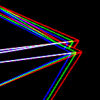I want to create huge territories. Preferably generated (POLYGONAL, NO CUBES), builded like Vue's , or Dreamscapes's, based on real world.
What i want to avoid is huge numbers problem. Like in minecraft if you go to what they call "Far lands", due to
pos_x 120123123.12312301239 , everything goes into astral and bug/glitches/probably lags.
I assume i can switch player local coords parent, rebinding it to terrain pieces (2km square for example), this will cut lags to some level.
But still, terrain will have world coords. So i imagine i must create different root's, for each 100km^2 for example.
And switch them under player.
Any thoughts on that?





